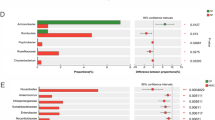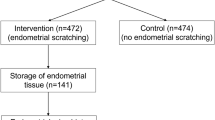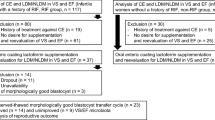Abstract
Purpose
Whether the dominant status of vaginal Lactobacillus is associated with IVF/ICSI outcomes.
Methods
This is a propensity score-matched retrospective cohort study consists of 2285 women undergoing their first fresh autologous IVF cycles. We divided the patients into the Lactobacillus-dominant group and non-Lactobacillus-dominant group based on the abundance of Lactobacillus in Gram-stained vaginal smear examined by microscopy. We compared IVF outcomes between the two groups. We matched Lactobacillus-dominant women with non-Lactobacillus-dominant women by propensity score (PS) to reduce the impact of confounding factors. We evaluated the effect of vaginal Lactobacillus on live birth using univariate and multivariate analysis models. We also conducted interaction and stratified analyses.
Results
Compare to the Lactobacillus-dominant group, the biochemical pregnancy rate (50.12% vs. 57.61%, P = 0.03), clinical pregnancy rate (40.98% vs. 50.82%, P < 0.01), and live birth rate (31.83% vs. 41.22%, P < 0.01) were significantly lower in the non-Lactobacillus-dominant group, the preclinical pregnancy loss rate (18.22% vs. 11.79%, P = 0.05) and preterm birth rate (33.09% vs. 21.59%, P = 0.02) were significantly higher in the non-Lactobacillus-dominant group. However, the miscarriage rate (18.86% vs. 15.67%, P = 0.40) and ectopic pregnancy rate (1.41% vs.1.64%, P = 0.78) were similar between the two groups. Loss dominance of Lactobacillus in the vagina was an independent risk factor for live birth (OR 0.66, 95% CI 0.50–0.88).
Conclusions
Loss dominance of Lactobacillus in the vagina negatively affects IVF outcomes by decreasing the chances of pregnancy and live birth, increasing risks of preclinical pregnancy loss and preterm birth.



Similar content being viewed by others
Availability of data and materials
The data sets used and/or analyzed during the current study are available from the corresponding author on reasonable request.
Abbreviations
- IVF:
-
In-vitro fertilization
- ICSI:
-
Intracytoplasmic sperm injection
References
Aldunate M, Srbinovski D, Hearps AC et al (2015) Antimicrobial and immune modulatory effects of lactic acid and short chain fatty acids produced by vaginal microbiota associated with eubiosis and bacterial vaginosis. Front Physiol 6:164
Nene NR, Reisel D, Leimbach A et al (2019) Association between the cervicovaginal microbiome, BRCA1 mutation status, and risk of ovarian cancer: a case-control study. Lancet Oncol 20(8):1171–1182
Haahr T, Jensen JS, Thomsen L et al (2016) Abnormal vaginal microbiota may be associated with poor reproductive outcomes: a prospective study in IVF patients. Hum Reprod 31(4):795–803
Babu G, Singaravelu BG, Srikumar R, Reddy SV, Kokan A (2017) Comparative study on the vaginal flora and incidence of asymptomatic vaginosis among healthy women and in women with infertility problems of reproductive age. J Clin Diagn Res 11(8):DC18–DC22
Elovitz MA, Gajer P, Riis V et al (2019) Cervicovaginal microbiota and local immune response modulate the risk of spontaneous preterm delivery. Nat Commun 10(1):1305
Haahr T, Zacho J, Brauner M et al (2019) Reproductive outcome of patients undergoing in vitro fertilisation treatment and diagnosed with bacterial vaginosis or abnormal vaginal microbiota: a systematic PRISMA review and meta-analysis. BJOG 126(2):200–207
Ravel J, Gajer P, Abdo Z et al (2011) Vaginal microbiome of reproductive-age women. Proc Natl Acad Sci USA 108(Suppl 1):4680–4687
Drell T, Lillsaar T, Tummeleht L et al (2013) Characterization of the vaginal micro- and mycobiome in asymptomatic reproductive-age Estonian women. PLoS One 8(1):e54379
Makarova K, Slesarev A, Wolf Y et al (2006) Comparative genomics of the lactic acid bacteria. Proc Natl Acad Sci U S A 103(42):15611–15616
Witkin SS, Linhares IM (2017) Why do lactobacilli dominate the human vaginal microbiota? BJOG 124(4):606–611
Bernabeu A, Lledo B, Diaz MC et al (2019) Effect of the vaginal microbiome on the pregnancy rate in women receiving assisted reproductive treatment. J Assist Reprod Genet 36(10):2111–2119
Vergaro P, Tiscornia G, Barragan M et al (2019) Vaginal microbiota profile at the time of embryo transfer does not affect live birth rate in IVF cycles with donated oocytes. Reprod Biomed Online 38(6):883–891
Walker B (1998) Biodiversity and ecological redundancy. Conserv Biol 6:18–23
Hickey RJ, Zhou X, Pierson JD, Ravel J, Forney LJ (2012) Understanding vaginal microbiome complexity from an ecological perspective. Transl Res 160(4):267–282
Nugent RP, Krohn MA, Hillier SL (1991) Reliability of diagnosing bacterial vaginosis is improved by a standardized method of gram stain interpretation. J Clin Microbiol 29(2):297–301
Moreno I, Codoner FM, Vilella F et al (2016) Evidence that the endometrial microbiota has an effect on implantation success or failure. Am J Obstet Gynecol 215(6):684–703
Spandorfer SD, Neuer A, Giraldo PC, Rosenwaks Z, Witkin SS (2001) Relationship of abnormal vaginal flora, proinflammatory cytokines and idiopathic infertility in women undergoing IVF. J Reprod Med 46(9):806–810
Burton JP, Reid G (2002) Evaluation of the bacterial vaginal flora of 20 postmenopausal women by direct (Nugent score) and molecular (polymerase chain reaction and denaturing gradient gel electrophoresis) techniques. J Infect Dis 186(12):1770–1780
Brotman RM, Shardell MD, Gajer P et al (2018) Association between the vaginal microbiota, menopause status, and signs of vulvovaginal atrophy. Menopause 25(11):1321–1330
Al-Memar M, Bobdiwala S, Fourie H et al (2020) The association between vaginal bacterial composition and miscarriage: a nested case-control study. BJOG 127(2):264–274
Romero R, Hassan SS, Gajer P et al (2014) The composition and stability of the vaginal microbiota of normal pregnant women is different from that of non-pregnant women. Microbiome 2(1):4
Greenbaum S, Greenbaum G, Moran-Gilad J, Weintraub AY (2019) Ecological dynamics of the vaginal microbiome in relation to health and disease. Am J Obstet Gynecol 220(4):324–335
Serrano MG, Parikh HI, Brooks JP et al (2019) Racioethnic diversity in the dynamics of the vaginal microbiome during pregnancy. Nat Med 25(6):1001–1011
Tabatabaei N, Eren AM, Barreiro LB et al (2019) Vaginal microbiome in early pregnancy and subsequent risk of spontaneous preterm birth: a case-control study. BJOG 126(3):349–358
Romero R, Hassan SS, Gajer P et al (2014) The vaginal microbiota of pregnant women who subsequently have spontaneous preterm labor and delivery and those with a normal delivery at term. Microbiome 2:18
Verwijs MC, Agaba SK, Darby AC, van de Wijgert J (2020) Impact of oral metronidazole treatment on the vaginal microbiota and correlates of treatment failure. Am J Obstet Gynecol 222(2):157.e151-157.e113
Husain S, Allotey J, Drymoussi Z et al (2020) Effects of oral probiotic supplements on vaginal microbiota during pregnancy: a randomised, double-blind, placebo-controlled trial with microbiome analysis. Bjog 127(2):275–284
Bhandari P, Rishi P, Prabha V (2016) Positive effect of probiotic Lactobacillus plantarum in reversing LPS-induced infertility in a mouse model. J Med Microbiol 65(5):345–350
Vitali B, Cruciani F, Baldassarre ME et al (2012) Dietary supplementation with probiotics during late pregnancy: outcome on vaginal microbiota and cytokine secretion. BMC Microbiol 12:236
Stojanovic N, Plecas D, Plesinac S (2012) Normal vaginal flora, disorders and application of probiotics in pregnancy. Arch Gynecol Obstet 286(2):325–332
Funding
Not applicable.
Author information
Authors and Affiliations
Contributions
HZ designed the study, performed the statistical analyses, drafted the manuscript, tables and figures; HX performed the statistical analyses, revised the tables and figures; RKA and LH collected and organized the data. DH, LZ and BJ collected the participants’ information, revised the manuscript; NL and HX designed the study and revised the manuscript.
Corresponding authors
Ethics declarations
Conflict of interest
The authors declare they have no conflict of interest.
Ethics approval
The Ethics Committee of Xiangya Hospital approved this study.
Informed consent
Since this was a retrospective analysis of data routinely collected from treatments and patients, the informed consensus was not required.
Consent for participation
Since this was a retrospective analysis of data routinely collected from treatments and patients, consent for participation was not applicable.
Consent for publication
Since this was a retrospective analysis of data routinely collected from treatments and patients, consent for publication was not applicable.
Additional information
Publisher's Note
Springer Nature remains neutral with regard to jurisdictional claims in published maps and institutional affiliations.
Supplementary Information
Below is the link to the electronic supplementary material.
Rights and permissions
About this article
Cite this article
Zeng, H., He, D., Hu, L. et al. Non-Lactobacillus dominance of the vagina is associated with reduced live birth rate following IVF/ICSI: a propensity score-matched cohort study. Arch Gynecol Obstet 305, 519–528 (2022). https://doi.org/10.1007/s00404-021-06171-y
Received:
Accepted:
Published:
Issue Date:
DOI: https://doi.org/10.1007/s00404-021-06171-y




